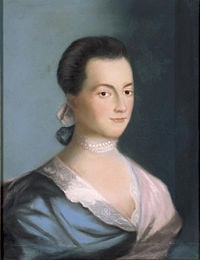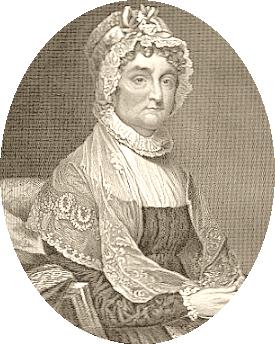Difference between revisions of "Abigail Adams" - New World Encyclopedia
Laura Brooks (talk | contribs) |
Laura Brooks (talk | contribs) |
||
| Line 44: | Line 44: | ||
</table> | </table> | ||
| − | '''Abigail Smith Adams''' | + | '''Abigail Smith Adams''' was the wife of the second President of the United States, and is seen as the second [[First Ladies of the United States|First Lady of the United States]], though that term was not coined until after her death. |
| + | |||
| + | Abigail Adams helped plant the seeds that would start women and men thinking about women's rights and roles in a country that had been founded on the ideals of equality and independence. | ||
== Early life == | == Early life == | ||
Revision as of 15:51, 13 October 2006
|
||||||||||||
Abigail Smith Adams was the wife of the second President of the United States, and is seen as the second First Lady of the United States, though that term was not coined until after her death.
Abigail Adams helped plant the seeds that would start women and men thinking about women's rights and roles in a country that had been founded on the ideals of equality and independence.
Early life
Abigail was born as Abigail Smith on November 11, 1744 in Weymouth, Massachusetts, to the Rev. William Smith and Elizabeth Quincy. Abigail was raised simply and without pretension, though her relatives, especially on her mother's side, were among the leading families of their time. Her mother's relatives were descended from the Quincys, a family of great prestige in the Massachusetts colony; her father and other forebearers were Congregational ministers, leaders in a society that held its clergy in high esteem.
At a young age, Abigail's father urged her to read, and she did so voraciously. Although she had not received a formal education, her father had a large library of books to which he gave Abigail unfettered access. Still her lack of education later embarrassed her. She was self-conscious about her inability to spell and punctuate properly or to speak or read French.
Developed solely from self-education, Abigail's ideas on women's rights and government would eventually play a major role—although indirectly—in the founding of the United States.
Marriage to John Adams
Abigail Smith married John Adams in 1764. The young couple lived on John's small farm at Braintree which later was renamed Quincy. Later when John's law practice began to flourish they moved to Boston. In ten years they had five children: Abigail Amelia, future President John Quincy Adams, Susanna Boylston, Thomas Boylston, and a daughter named Elizabeth who was stillborn.
A cairn now crowns the nearby hill from which she and her son John Quincy watched the Battle of Bunker Hill and burning of Charlstown. At that time she was minding the children of Dr. Joseph Warren, President of the Massachusetts Provincial Congress, who was killed in the battle.
During the Revolution, Abigail wrote many letters that she is now famous for. Her letters talked about current politics and expressed her opinions. When John was serving in the Continental Congress, Abigail wrote him a letter, telling him to "remember the ladies" when making the nation's new laws. Though Abigail really tried to give women more rights, the American Revolution didn’t do very much in that respect. The new state bills said that all the people were equal, but only white males had the full privileges of citizenship. It was clear in the letters that Abigail wrote that she was a Federalist. Her letters and writings are remembered as some of the best of her time.
In 1784, she joined John Adams at his diplomatic post in Paris. After 1785, she filled the role of wife of the first United States Minister to the Kingdom of Great Britain. They returned in 1788 to a house known as the "Old House" in Quincy, which she set about vigorously enlarging and remodeling. It is still standing and open to the public as part of Adams National Historical Park.
As wife of the second President of the United States, Abigail became a good friend to Martha Washington and helped in official entertaining, drawing on her experience of courts and society abroad. After 1791, poor health forced her to spend most of her time in Quincy.
As "First Lady", and after
When John Adams was elected President of the United States, she continued a formal pattern of entertaining, becoming the first hostess of the yet uncompleted White House. Her account of the new but very incomplete Georgian mansion is quite entertaining: fires had to be lit constantly to keep the cold, cavernous place warm and she describes setting up her laundry in one of the great rooms.
Abigail and John retired to Quincy in 1801. Abigail died in 1818 of typhoid fever, and is buried beside her husband in the United First Parish Church (also known as the Church of the Presidents). Her last words were "Do not grieve, my friend, my dearest friend. I am ready to go. And John, it will not be long".
An Adams Memorial is proposed in Washington, D.C., honoring Abigail, her husband, and other members of their family.
| Preceded by: Martha Washington |
First Lady of the United States 1797–1801 |
Succeeded by: Martha Jefferson Randolph |
Credits
New World Encyclopedia writers and editors rewrote and completed the Wikipedia article in accordance with New World Encyclopedia standards. This article abides by terms of the Creative Commons CC-by-sa 3.0 License (CC-by-sa), which may be used and disseminated with proper attribution. Credit is due under the terms of this license that can reference both the New World Encyclopedia contributors and the selfless volunteer contributors of the Wikimedia Foundation. To cite this article click here for a list of acceptable citing formats.The history of earlier contributions by wikipedians is accessible to researchers here:
The history of this article since it was imported to New World Encyclopedia:
Note: Some restrictions may apply to use of individual images which are separately licensed.

